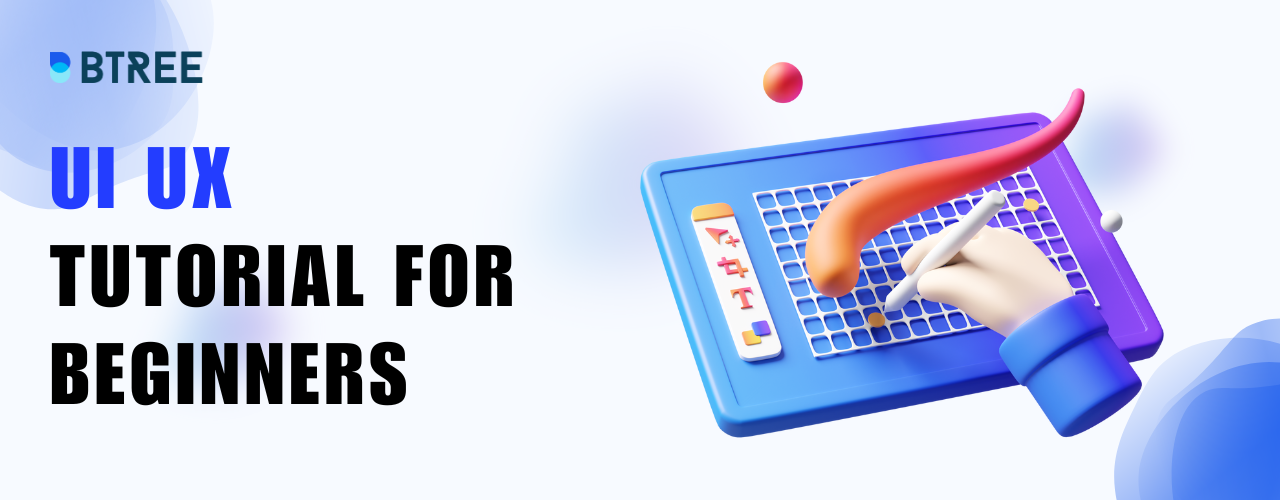UI UX Tutorial

What's UI UX Design?
Imagine navigating your go-to app effortlessly, as if it was custom-made for you. This is where the magic happens. User Interface (UI) works on buttons, menus, and layouts that ensure apps are user-friendly. User Experience (UX) tailors experiences to leave users content and eager to revisit a product.
UI UX design is more than just aesthetics; it's about functionality, solving issues, and creating fun digital interactions. Think of smooth swipes on your phone or a website that's simple to navigate – that's UI UX design working its charm.
Let's dig deep into UI UX tutorial for beginners to learn the essential concepts behind successful UI UX design. We'll talk about UI and UX roles and how they shape products users fall in love with. If this is new territory, don't worry – we'll simplify complex concepts. So, whether you're contemplating a design career or simply curious about UI UX, get ready!
How Does UI UX Design Impact Our Digital World?
Think of UI and UX as two friends who work together to make things on the computer or phone really good. UI is like the artist who makes everything look nice, like picking pretty colors, cool fonts, and buttons that you can click. UX is like the helper who makes sure you can use everything easily and that it feels nice when you use it.
UI focuses on how things look, like making a painting look beautiful. It decides how everything appears on the screen and how you can interact with it. UX cares about how you feel while using the computer or phone. It wants to make sure you can do things without any confusion, and that you enjoy using what's on the screen.
UI and UX have different jobs, but they're like best friends who need each other. UI makes things look amazing, like when you see a picture that makes you go "Wow!" But then UX steps in to make sure you can use everything without any problems. UI and UX work together to create a splendid experience for you.
When UI and UX work well together, it's like magic. A beautiful UI catches your eye and makes you want to use things, while a smart UX makes sure you can use everything smoothly. They're like a perfect team that makes things both good-looking and easy to use. This coordinated teamwork is extremely important, and when designers, computer experts, and other smart people work together, they can make awesome things that you'll love using.
Key Elements Of An Effective Design
Effective design goes beyond just looking nice – it's about creating experiences that are both visually pleasing and functional. Let's delve into the key elements that make design effective.
Consistency: Consistency is like the glue that holds a design together. Using the same layout, color palette, and font across your project creates connection and familiarity. This helps users to navigate and interact with your product pretty easily. When users encounter familiar patterns and visual cues, they feel more comfortable exploring your design.
Hierarchy: Hierarchy guides users through your content by emphasizing certain elements. This can be achieved through varying font sizes, contrasting colors, and strategic placement. A clear hierarchy ensures that users know what's important and where to look first. By directing users' attention effectively, you help them understand the information hierarchy and the sequence of actions to take.
Simplicity: One of the fundamental principles of effective design is simplicity. Keeping things tidy and uncomplicated allows users to zero in on the content and tasks at hand. Simple designs are easier to navigate and understand. When elements are straightforward and easy to grasp, users are more likely to engage with your content.
Color and Contrast: Colors evoke emotions and set the tone for your design. Effective use of color can convey the right message and create visual interest. Contrast ensures that elements stand out from each other, making content easier to read and navigate. Bold color choices and strategic contrast can direct users' focus where you want it, enhancing usability.
Typography: Fonts play a significant role in design. They can make or break a design, Choosing the right fonts for headings, subheadings, and body text improves readability and reinforces the overall style of your project. People think that typography is just about choosing pretty fonts, in fact it's about selecting fonts that align with your brand's voice and values.
Whitespace: Whitespace, or negative space, isn't just empty space – it's a powerful design tool. It helps to create a sense of balance, highlights important elements, and reduces visual clutter. Adequate whitespace gives your design room to breathe and prevents it from feeling overwhelming.
Visual Feedback: Providing visual cues when users interact with elements can improve usability. For instance, buttons changing color when hovered over or clicked provide immediate feedback that a user's action has been recognized. Visual feedback creates a more responsive and interactive experience.
Accessibility: Effective design is inclusive design. Ensuring that your design is accessible to people with disabilities is not only the right thing to do but also a legal requirement in many cases. This involves considerations such as readable fonts, proper color contrast, and accommodating screen readers. Making your design accessible ensures that everyone can engage with your content.
User-Centered Design: Ultimately, effective design revolves around the needs and preferences of the users. Understanding their behavior, goals, and pain points allows you to create designs that genuinely cater to their needs. User-centered design involves continuous research, testing, and refinement based on user feedback.
Good scores in the categories of visual feedback, accessibility, hierarchy, color, typography, consistency, whitespace, and user-centeredness are essential for the core elements of successful design. Together, these elements deliver designs that not only look spectacular but also improve user experience. Designers can create engaging, user-friendly, and impactful products by emphasizing on these principles.
Steps to Ensure User-Centered Design Process
Now that we know which key elements make up an effective design, let's move on to explore the user-centered approach to design, where the needs and preferences of users are given top priority.
In the world of design, making users a priority isn't just an idea – it's a strategic move that leads to successful and impactful outcomes. The people-centric approach revolves around grasping your audience's needs, sympathizing with their requirements, and crafting experiences that deeply resonate.
Understanding Audience Needs: The people-centric approach begins with empathy. You must step into users' shoes, comprehending their objectives, hurdles, and anticipations. This necessitates thorough research for insights into their behaviors and inclinations. By genuinely understanding users, you can shape solutions that cater to their genuine needs.
Designing for Actual Individuals: Designing with genuine users in mind is crucial. Steer clear of assuming what users want or require. Instead, involve them directly through surveys, interviews, and testing. This ensures that design choices are anchored in solid feedback rather than mere assumptions.
Formulating Personas: Personas are crafted characters representing target users. They assist in visualizing and comprehending distinct user types, their aspirations, and pain points. Creating intricate personas enables designs tailored to specific user needs.
User Journeys: A user journey lays out the entire interaction users have with your offering. It encompasses every point of contact, from initial engagement to goal attainment. Understanding this journey helps identify issues and prospects for enhancement, guaranteeing a smooth, gratifying experience.
Repetitive Design: The people-centric approach is an ongoing process. It encompasses consistent feedback and adjustment. After implementing a design, garner user input and scrutinize their interactions. This informs decisions about what works and what necessitates tweaking. Reiteration is pivotal for refining design to align with user expectations.
User-Centric Gains: Designing with users at heart leads to a multitude of benefits. Users are inclined to connect with and relish offerings that address their needs. This leads to heightened user satisfaction, bolstered brand allegiance, and favorable word-of-mouth recommendations.
Harmonizing Business Goals: While user needs are paramount, it's also imperative to harmonize them with business objectives. A triumphant design doesn't just fulfill user needs, but also aligns with organizational aims. The people-centric approach seeks equilibrium between user satisfaction and achieving business outcomes.
Inclusivity and Diversity: The people-centric approach advocates inclusiveness. Designing for an array of users ensures offerings are reachable and functional for a broad audience. By accommodating various needs and backgrounds, a more comprehensive digital atmosphere is formed.
The people-centric approach to design serves as a compass guiding you to forge experiences that resonate profoundly with actual users. By immersing in their needs, inclinations, and practices, you shape products that yield positive influence. Thus, whether you're building a webpage, an app, or any digital product, keep in mind that the people-centric approach is your pathway to triumph.
Why is User Research Essential in UI UX Design?
In UI UX design, creating interfaces that truly connect with users demands more than artistic flair. It's about comprehending users – their needs, preferences, and behaviors. This is where user research shines, illuminating the path for designers to create genuinely engaging experiences.
User research involves gathering data about user-product interactions. This can be done through surveys, interviews, analytics, and observations. The goal is to extract insights that inform design decisions. By aligning designs with user behaviors, interfaces become both visually pleasing and interactive.
Our Lovely Student feedback
Different methods of user research?
Surveys and Questionnaires: Gathering opinions from a broad audience unveils user demographics, needs, and pain points.
User Interviews: Direct conversations provide deeper insights into motivations and challenges, offering a qualitative understanding.
Observational Research: Watching users interact highlights pain points and usability issues, aiding improvements.
Analytics and User Tracking: Analytics tools uncover patterns in user behavior, guiding feature enhancements.
Persona Development: Crafting personas based on research helps designers empathize and tailor designs to user needs.
How user research impacts the design of interfaces?
User research is foundational to effective UI UX design. It informs choices about layout, navigation, and functionality, resulting in user-friendly designs.
Benefits of User Research
Empathy-driven Design: Research enables designers to grasp user frustrations, leading to resonating designs.
Reduced Redesigns: Early user insights prevent major design overhauls, saving time and effort.
Enhanced User Satisfaction: User-tailored products foster engagement and loyalty.
Informed Innovation: Research identifies areas for improvement, pushing boundaries while meeting user expectations
User research acts as a guiding compass in the creative process. Understanding user behavior crafts experiences that are both visually striking and functionally seamless.
What are user profiles, and how do they help in design?
When it comes to designing interfaces that truly connect with users, it's vital to understand the people who will be using your product. This is where user personas come into play – they're like your design's best friends, offering insights that guide every creative decision.
User personas are fictional characters that represent different types of users. Think of them as snapshots of your target audience. Each persona encapsulates key information like age, occupation, goals, and pain points. These personas are built from real data and research, giving you a tangible reference for who you're designing for.
How do you create effective user personas?
Research: Start by gathering data about your users through surveys, interviews, and analytics. This helps you identify common traits and behaviors.
Identify Patterns: Group similar users together based on their behaviors, needs, and preferences. These groups become the foundation for your personas.
Add Detail: Bring your personas to life by giving them names, faces, and stories. This makes them relatable and memorable.
Goals and Challenges: Understand what each persona wants to achieve with your product and what challenges they might face. This guides your design decisions.
How do user personas impact the design process?
Personas act as your users' advocates during the design process. They prevent you from designing in a vacuum and keep you focused on what matters most to your audience.
Benefits of using user personas in UX UI design?
Empathy-Driven Design: Personas help you step into your users' shoes, leading to designs that resonate with their real-world needs.
Decision Making: When faced with design choices, you can ask, "What would this persona prefer?" This keeps your decisions user-centered.
Tailored Experiences: Designing for specific personas ensures that your product caters to different user segments, enhancing overall satisfaction.
Clear Communication: Personas help teams align by providing a shared understanding of the target audience, reducing confusion.
Creating user personas goes beyond crafting fictional profiles; it's a way of designing with genuine users at the forefront. These personas steer your design journey, ensuring it addresses real needs and desires, ultimately transforming your approach from one-size-fits-all to personalized experiences for every individual user.
What's Wireframing and Design Prototyping?
Designing an exceptional user interface (UI) and user experience (UX) doesn't happen by chance. It's a deliberate process that involves careful planning and iteration. This is where design prototyping and wireframing step in, providing the scaffolding upon which intuitive and engaging digital experiences are built.
What's Wireframing and Why is it Used?
Wireframing is the blueprint of your design concept. It's the initial sketch that outlines the structure, layout, and placement of key elements on a screen. By focusing solely on the arrangement and functionality, wireframes strip away distractions, allowing designers to lay a strong foundation for the UI UX.
Wireframes serve as the skeletal structure of your design, showcasing the hierarchy of content and interactions. They guide decisions about where buttons, images, and text will reside, paving the way for a coherent and user-friendly interface.
What's Design Prototyping and How Does it Work?
Once the wireframes set the structural stage, design prototypes bring the concept to life. Prototyping involves adding interactive elements to the wireframe, allowing you to simulate how the final product will function. This step is crucial for understanding how users will navigate and interact with the interface.
Design prototypes allow for user testing and feedback, helping to identify potential flaws and opportunities for improvement early in the process. They also aid in aligning the design vision across teams and stakeholders, reducing misunderstandings and ensuring a smoother development journey.
The Symbiotic Relationship of Wireframing and Design Prototyping
Wireframing and design prototyping are symbiotic stages in the UI UX design process. While wireframes provide the logical structure, design prototypes inject interactivity and usability into the equation. This combination enables designers to iteratively refine their designs, making informed adjustments before full-scale development begins.
Within the ever-evolving UI UX design landscape, wireframing and design prototyping emerge as vital pillars. They bridge the gap between ideas and reality, enabling designers to refine their concepts through interactive models. By embracing these methodologies, designers pave the way for captivating digital experiences that resonate deeply with users.
What is Usability Testing and User Feedback?
The UI UX design journey extends beyond creation to embrace refinement. Usability testing and user feedback take center stage as indispensable tools for crafting experiences that truly resonate.
What's Usability Testing?
Usability testing puts your design to the test in the hands of real users. It uncovers how users interact with your interface, highlighting pain points, confusing elements, and areas of delight. By observing actual usage, designers gain invaluable insights into how their creations function in the wild.
Usability testing serves as a reality check, guiding designers to identify where the design aligns with user expectations and where improvements are warranted. This iterative process ensures that the final product is as user-friendly as possible.
What is User Feedback?
User feedback is a treasure trove of insights directly from the people who matter most – the users themselves. This feedback, gathered through surveys, reviews, and direct communication, offers a window into user preferences, needs, and frustrations.
Designers can glean not only what works but also what needs enhancement. User feedback is a continuous loop of improvement, empowering designers to iterate and tailor their designs to better serve their audience.
How Does User Feedback and Usability Testing Guide Design Refinement?
Usability testing and user feedback form a harmonious duet, guiding designers on a journey of continuous improvement. They equip designers with the data needed to refine designs iteratively, ensuring that every tweak brings the design closer to perfection.
Usability testing and user feedback are the compass guiding designers toward design excellence. These practices offer real-world insights that refine designs iteratively, resulting in experiences that truly resonate with users. Through continuous refinement, designers bridge the gap between creativity and usability, creating interfaces that make a lasting impact.
Ultimate UI UX Tools
In this section, we'll delve into the essential tools and technologies that empower UI UX designers to transform their innovative ideas into captivating digital experiences. These tools are your trusted partners throughout the design journey, helping you create user-friendly interfaces, intuitive prototypes, and seamless user flows. Let's dive into the toolkit that forms the foundation of outstanding design solutions.
Design Software: Craft visually appealing interfaces, wireframes, and prototypes with graphic design software like Adobe XD, Sketch, or Figma. These platforms act as your virtual canvases, bringing your ideas to life.
Wireframing Tools: Create blueprint-like layouts to outline your design's structure using tools like Balsamiq or Axure RP. Wireframes offer a clear visual representation of your concepts.
Prototyping Platforms: Test user flows effectively by building interactive prototypes. Tools like InVision or Marvel allow you to simulate user interactions, enabling you to gather valuable feedback.
User Testing Software: Understand how real users interact with your designs using usability testing tools like UserTesting or Maze. Identify areas for improvement based on user behavior.
User Feedback Tools: Gain insights through heatmaps, session recordings, and direct user feedback using tools like Hotjar or Lookback. User feedback is a treasure trove of design enhancements.
Responsive Design Checkers: Ensure your design functions seamlessly across diverse devices with tools like Responsinator or BrowserStack. Test responsiveness and adaptability effortlessly.
Color Palette and Typography Tools: Select captivating color schemes using tools like Colors or Adobe Color. Explore typography options with resources like Typekit to enhance visual appeal.
Collaboration Platforms: Collaborate seamlessly with design teams using platforms like Slack, Microsoft Teams, or Trello. Effective communication is vital for successful UI UX projects.
Version Control Systems: Maintain design consistency in team projects with version control tools like GitHub or Bitbucket. Keep everyone on the same page, avoiding conflicts.
Analytics Tools: Track user behavior and guide iterative improvements with tools like Google Analytics or Mixpanel. Data-driven insights lead to more refined designs.
Remember, the tools you choose should align with your workflow and project requirements. As the UI UX field evolves, staying updated with new tools and technologies will keep your designs fresh and innovative.
UI UX Career Paths
UI UX design is an enticing realm for those driven to craft exceptional digital experiences. This field encompasses diverse roles, each essential in shaping user interactions. Let's explore some of the intriguing paths within UI UX careers:
UI Designer: These digital artists create visually captivating and user-friendly interfaces by blending color, typography, and layout for both aesthetics and usability.
UX Researcher: UX researchers delve into user behavior, employing surveys and data analysis to uncover insights that inform design decisions.
Interaction Designer: Crafting seamless user flows and engaging interactions is the focus of interaction designers, ensuring smooth navigation across applications and websites.
UX Writer: Words matter in design. UX writers shape user language for clarity and effectiveness, from labels to instructions.
Accessibility Specialist: These experts ensure inclusivity, guaranteeing digital experiences serve all users, irrespective of disabilities.
Prototyper / Wireframer: Prototypes and wireframes breathe life into concepts using interactive mockups, aiding visualization and iteration prior to development.
UX Architect: With a holistic view, UX architects plan and strategize the complete user experience, aligning it with business goals and user needs.
Education in design, psychology, or technology forms the foundation for a UI UX career. Adaptability is crucial, given the rapid evolution of technology. The excitement of UI UX careers lies in their direct impact on user interactions, leading to amplified satisfaction and engagement. Whether you're drawn to aesthetics, research, or strategy, UI UX offers fulfilling paths where creativity and innovation flourish.
Ready to dive into the UI UX field? Unlock careers as a UI Designer, UX Researcher, and more. Our Beginner-Friendly UI UX Course in Chennai empowers you to master user-centric design.
Conclusion
In this UI UX Tutorial for beginners every ui ux aspirant can learn design, aesthetics and functionality unite to create digital experiences that captivate and engage. From understanding the roles of UI and UX to mastering key design elements, this journey delved deep into the art and science of user-centric design. Empathy-driven approaches, user insights, and refined designs emerged as essential tools for success. As you step into the UI UX world, diverse career paths beckon, offering exciting opportunities to shape the digital landscape.
Looking to start your UI UX journey? Check out our beginner-friendly UI UX Course in Chennai, where you can unravel the secrets of crafting exceptional digital experiences. Your adventure in the world of design awaits!
Course Schedule
| Name | Batches | Details |
|---|---|---|
| Azure DevOps Training |
Weekend Batch
(Sat-Sun) |
View Details |
| AWS DevOps Training |
Weekday Batch
(Mon-Fri) |
View Details |
| Microsoft Azure Training |
Weekend Batch
(Sat-Sun) |
View Details |









